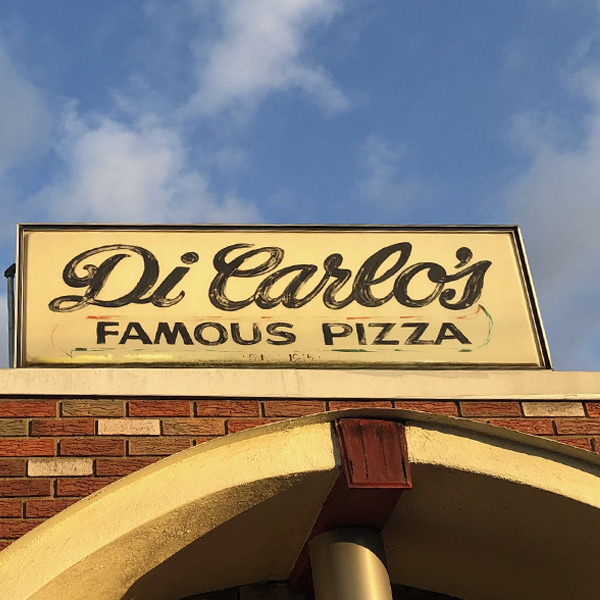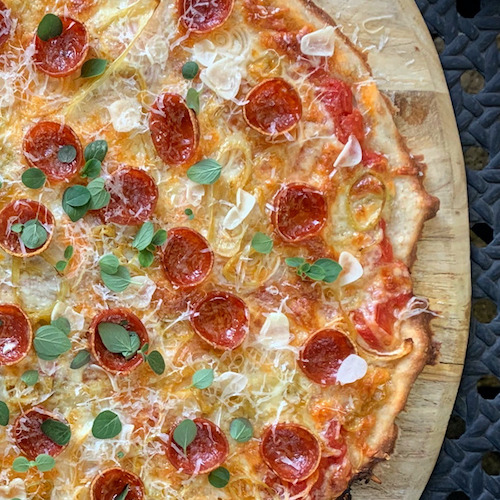Chicago, like many cities, jumped on the pan pizza bandwagon this year. People spending long days at home wanted nothing so much as a hearty, square-cut slab of cheesy action, preferably one dotted with grease-collecting cups of pepperoni. Restaurants that served small plates and charcuterie pivoted to Detroit-style pizza, underground Grandma pie pop-ups proliferated on the Instagram-Venmo black market, and one Michelin-starred chef traded his intimate restaurant for a Sicilian carryout window. All this in a town that’s synonymous with deep-dish.
But the truth is that none of those pizzas are what most Chicagoans most crave. Not even deep-dish—which most regard as an infrequent indulgence, like cheese fondue. All those others were a nice change of pace during a trying year, but chances are that when someone in this city orders from their favorite local pizzeria, they’ll get a tavern-style pie.
My wife and I learned that five years ago, on one of our first nights in town. We were unpacking boxes and trying to defreak the cat. I ordered a pizza from a local franchise just up the street, and when it arrived, I was surprised to find it larger and flatter than expected. It was also cut into a proliferation of little squares rather than sector-shaped slices. “Is this even pizza?” my wife wondered.
Once the WTF feeling subsided, we found there was much to appreciate in that flat pizzaoid. The cracker crust had no yeasty character, but it was a fine, crisp foil for melted cheese. The little squares meant that we could hit our satiety points cleanly without cutting off any awkward slivers. Best of all, we could choose our pieces. My wife went for the cheese-heaped squares in the center. I preferred the weird little triangular edges with their crunchy perimeters. (I like to call those pieces “where the rubber meets the road.”)
This kind of pizza is called tavern-style, I learned, because it originated as a freebie handout in bars in the 1940s after the end of Prohibition. “It was a ploy by tavern owners and bartenders to sell more beer,” says Steve Dolinsky, author of Pizza City, USA: 101 Reasons Why Chicago is America’s Greatest Pizza Town. “If they gave you something salty to eat, you’d drink more. And when it was cut in those little squares, you could eat it off a cocktail napkin.”
Two of Chicago’s best-known pizzerias—Vito and Nick’s and Home Run Inn—started as bars before the owners realized where the real money was. Chicago in the 1940’s not like New York, where pizzaiolos hand tossed crusts in windows. Chicagoans rolled them out back in the kitchen. Once a taste for cracker crusts was established, many turned to mechanized dough sheeters, which helped create a local pizza style.
“This is the pizza everyone grew up on,” says Cecily Federighi, a partner in Pizza Fried Chicken Ice Cream. “Honestly, I don’t know many Chicagoans who actually eat deep-dish unless they have friends from Arizona in town.” This modest spot opened during the pandemic and developed enough of a cult following to attract the notice of Esquire magazine’s food critic, Jeff Gordinier, who put it on his list of best new American restaurants.
Federighi and her partners originally set out to bring—you guessed it—Sicilian pizza to Chicago, and they started by selling fat slices to eat on the outdoor patio. But as the temperature cooled and they began fielding more orders for delivery, they switched to tavern-style, which the menu describes as “a 16-inch cracker thin crust cut into perfect little squares.” In order to get it just right, they run the dough through a sheeter and then cold-cure the crusts for a week until they “almost get this leather skin,” she says. “That creates the cracker crunch.”
Other pizzas may have their moment, but in Chicago, that crunch will never go out of style.
Photo courtesy of Pizza Fried Chicken Ice Cream




